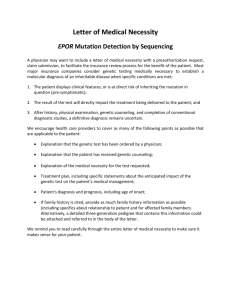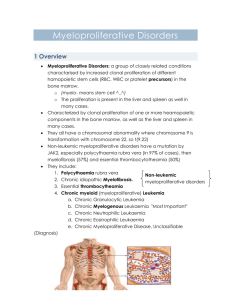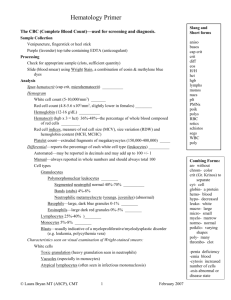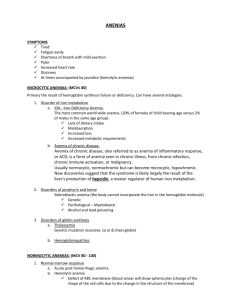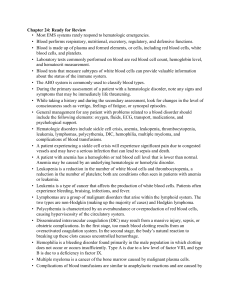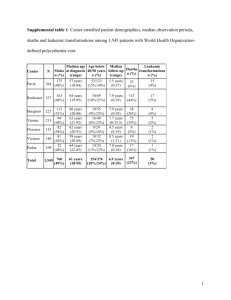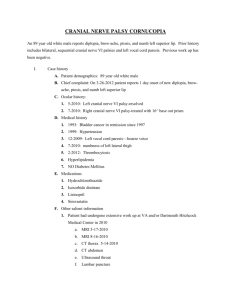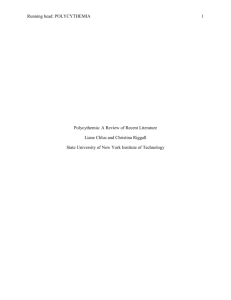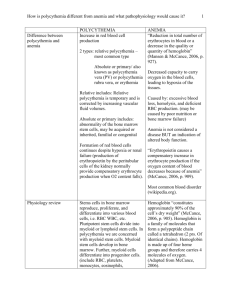increased_number_of_red_blood_cells
advertisement
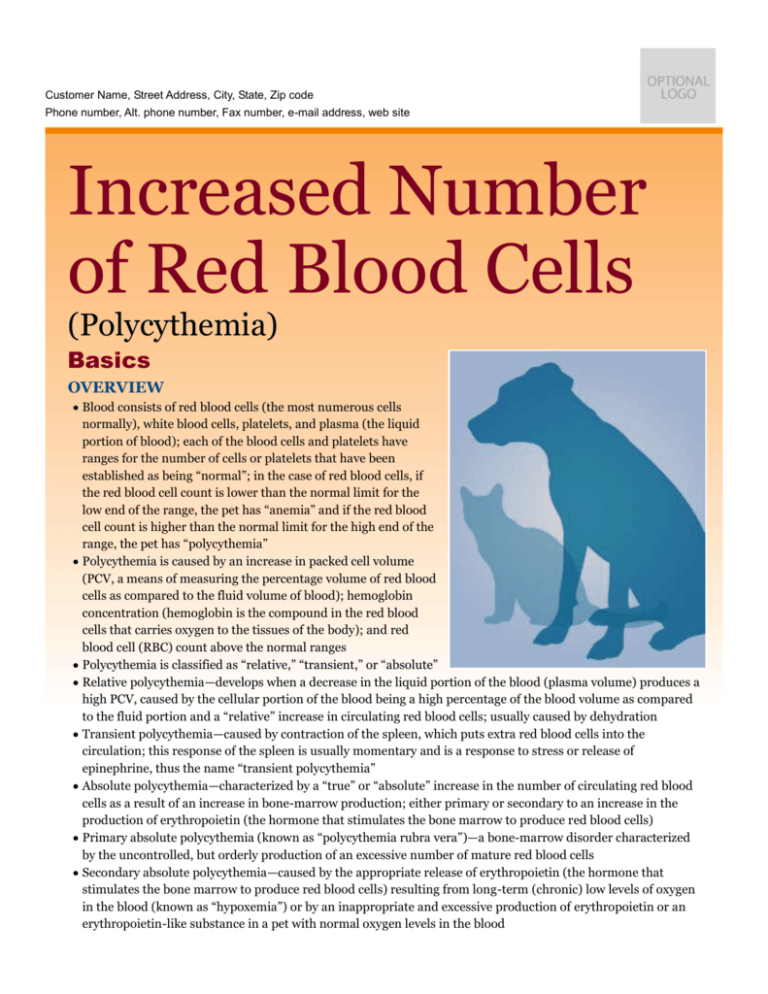
Customer Name, Street Address, City, State, Zip code Phone number, Alt. phone number, Fax number, e-mail address, web site Increased Number of Red Blood Cells (Polycythemia) Basics OVERVIEW • Blood consists of red blood cells (the most numerous cells normally), white blood cells, platelets, and plasma (the liquid portion of blood); each of the blood cells and platelets have ranges for the number of cells or platelets that have been established as being “normal”; in the case of red blood cells, if the red blood cell count is lower than the normal limit for the low end of the range, the pet has “anemia” and if the red blood cell count is higher than the normal limit for the high end of the range, the pet has “polycythemia” • Polycythemia is caused by an increase in packed cell volume (PCV, a means of measuring the percentage volume of red blood cells as compared to the fluid volume of blood); hemoglobin concentration (hemoglobin is the compound in the red blood cells that carries oxygen to the tissues of the body); and red blood cell (RBC) count above the normal ranges • Polycythemia is classified as “relative,” “transient,” or “absolute” • Relative polycythemia—develops when a decrease in the liquid portion of the blood (plasma volume) produces a high PCV, caused by the cellular portion of the blood being a high percentage of the blood volume as compared to the fluid portion and a “relative” increase in circulating red blood cells; usually caused by dehydration • Transient polycythemia—caused by contraction of the spleen, which puts extra red blood cells into the circulation; this response of the spleen is usually momentary and is a response to stress or release of epinephrine, thus the name “transient polycythemia” • Absolute polycythemia—characterized by a “true” or “absolute” increase in the number of circulating red blood cells as a result of an increase in bone-marrow production; either primary or secondary to an increase in the production of erythropoietin (the hormone that stimulates the bone marrow to produce red blood cells) • Primary absolute polycythemia (known as “polycythemia rubra vera”)—a bone-marrow disorder characterized by the uncontrolled, but orderly production of an excessive number of mature red blood cells • Secondary absolute polycythemia—caused by the appropriate release of erythropoietin (the hormone that stimulates the bone marrow to produce red blood cells) resulting from long-term (chronic) low levels of oxygen in the blood (known as “hypoxemia”) or by an inappropriate and excessive production of erythropoietin or an erythropoietin-like substance in a pet with normal oxygen levels in the blood SIGNALMENT/DESCRIPTION OF PET Species • Dogs • Cats Breed Predilections • Short-nosed, flat-faced (known as “brachycephalic”) breeds normally have higher packed cell volumes than do breeds with longer noses • Large, excitable breeds are prone to contraction of the spleen, and thus to transient polycythemia, where the spleen puts extra red blood cells into the circulation • Greyhounds typically have high PCVs as compared to other breeds; normal range for the breed is 50–65% Mean Age and Range • Primary absolute polycythemia—dogs: 7 years of age or older; cats: 6–7 years of age; primary absolute polycythemia (polycythemia rubra vera)—a bone-marrow disorder characterized by the uncontrolled, but orderly production of an excessive number of mature red blood cells Predominant Sex • Dogs—females • Cats—males SIGNS/OBSERVED CHANGES IN THE PET • Vary with the degree of increased number of red blood cells (polycythemia) • Relative polycythemia—dehydration (caused by vomiting, diarrhea, or lack of water intake) and production of only small amounts of urine (known as “oliguria”) • Transient polycythemia—excitement or vigorous exercise • Absolute polycythemia—sluggishness (lethargy); lack of appetite (known as “anorexia”); bleeding from the nose and nasal passages (known as “epistaxis” or a “nosebleed”); low exercise tolerance; behavioral change; brick-red or bluish moist tissues (known as “mucous membranes”) of the body caused by inadequate oxygen levels in the red blood cells (bluish discoloration known as “cyanosis”); sneezing; seizures; or stunted growth • Primary absolute polycythemia (polycythemia rubra vera)—variable degrees of enlargement of the spleen (known as “splenomegaly”) and of the liver (known as “hepatomegaly”), blood clots (known as “thrombosis”), and bleeding; occasional seizures • Secondary absolute polycythemia caused by low levels of oxygen in the body tissues (known as “hypoxia”)—signs of long-term (chronic) lung disease or heart disease • Secondary absolute polycythemia caused by inappropriate erythropoietin secretion—signs associated with cancer or either a kidney or hormonal disorder CAUSES • Relative polycythemia (common)—vomiting, diarrhea, diminished water intake, excessive urine production (known as “diuresis”), kidney disease, hyperventilation • Transient polycythemia—excitement, anxiety, seizures, and restraint • Primary absolute polycythemia (polycythemia rubra vera)—rare bone-marrow disorder • Secondary absolute polycythemia caused by low levels of oxygen in the body tissues (hypoxia)—long-term (chronic) lung disease; heart disease; living at high altitude; short-nosed, flat-faced (brachycephalic) breed conformation; and impairment of kidney blood supply • Secondary absolute polycythemia caused by inappropriate erythropoietin secretion (rare)—kidney disorder (such as a cyst or tumor); excessive production of steroids by the adrenal glands (known as “hyperadrenocorticism” or “Cushing's syndrome”); excessive production of thyroid hormone (known as “hyperthyroidism”); cancer; treatment with recombinant erythropoietin (EPO), used to stimulate the production of red blood cells in the bone marrow of anemic pets Treatment HEALTH CARE • Depends on type of polycythemia • Relative polycythemia—rehydration with intravenous (IV) fluids • Absolute polycythemia—phlebotomy (procedure in which blood is removed from the body via a vein) recommended to reduce the number of circulating red blood cells to a packed cell volume of 55%; the amount of blood removed should be replaced with IV fluids to prevent the development of low blood pressure (known as “hypotension”), heart and circulatory collapse (known as “cardiovascular collapse”), and blood clots (thrombosis) • Primary absolute polycythemia (polycythemia rubra vera)—phlebotomy (procedure in which blood is removed from the body via a vein) and hydroxyurea; frequency of bleeding and medication dosage adjusted to maintain a PCV of 55% in dogs and 45% in cats • Secondary absolute polycythemia caused by low levels of oxygen in the body tissues (hypoxia)—phlebotomy (procedure in which blood is removed from the body via a vein) and hydroxyurea; the high PCV is an appropriate compensatory response to the low levels of oxygen by the body; thus phlebotomy may be dangerous; if indicated, remove blood at a slower rate; a higher PCV (60–65%) may be necessary to sustain life until the cause of low levels of oxygen in the blood (hypoxemia) is identified and can be corrected • Secondary absolute polycythemia caused by inappropriate erythropoietin secretion—phlebotomy (procedure in which blood is removed from the body via a vein) and removal of the source of erythropoietin • Oxygen therapy may be needed for pets with bluish discoloration of the skin and moist tissues (mucous membranes) of the body caused by inadequate oxygen levels in the red blood cells (condition known as “cyanosis”); low levels of oxygen in the blood; or severe heart and lung disease ACTIVITY • Depends on type and severity of the polycythemia • Excessive exercise should be avoided DIET • Normal diet with free-choice water Medications Medications presented in this section are intended to provide general information about possible treatment. The treatment for a particular condition may evolve as medical advances are made; therefore, the medications should not be considered as all inclusive • Primary absolute polycythemia (polycythemia rubra vera)—hydroxyurea; also may use chlorambucil or busulfan • Secondary absolute polycythemia caused by low levels of oxygen in the body tissues (hypoxia)—hydroxyurea Follow-Up Care PATIENT MONITORING • In severely dehydrated pets, packed cell volume; total plasma protein (a quick laboratory test that provides general information on the level of protein in the fluid portion of the blood); urine output; and body weight are monitored 2–3 times daily until normal hydration is maintained • Pets being treated for primary absolute polycythemia (polycythemia rubra vera) by chemotherapy—monitor weekly for changes in PCV, white blood cell counts, and platelet counts during the initial treatment; then monthly for adjustment of chemotherapy and periodic phlebotomy (procedure in which blood is removed from the body via a vein); periodic testing for levels of iron in the bone marrow or blood are indicated to detect iron deficiency POSSIBLE COMPLICATIONS • Increased red blood cells in the blood leading to sludging of the blood (known as “hyperviscosity”) may occur in pets with absolute polycythemia, especially primary absolute polycythemia (polycythemia rubra vera); hyperviscosity may lead to blood clots (thrombosis), sudden lack of blood supply that leads to death of tissues (known as “infarction”), or bleeding • Chemotherapy may cause bone-marrow suppression, leading to low red blood cell and low white blood cell counts • Adverse effects of hydroxyurea include loss of cells in the bone marrow (known as “bone-marrow hypoplasia”) with resulting low platelet count (known as “thrombocytopenia”) and low neutrophil count (a neutrophil is a type of white blood cell; condition is known as “neutropenia”); hair loss (known as “alopecia”); changes in skin pigmentation; and sloughing of toe nails; hydroxyurea also may decrease or stop the production of sperm • Pets with absolute polycythemias can develop iron deficiency as a result of phlebotomy (procedure in which blood is removed from the body via a vein) and active production of red blood cells (known as “active erythropoiesis”) by the bone marrow EXPECTED COURSE AND PROGNOSIS • Relative polycythemia—identification and correction of the primary cause with appropriate fluid therapy result in recovery, with a fair to good prognosis, depending on primary cause • Prognosis in secondary absolute polycythemia caused by low levels of oxygen in the body tissues (hypoxia) depends upon the cause of the low levels of oxygen; improvement in heart function or lung disease with a reduction in packed cell volume should improve quality of life; prognosis remains guarded • Prognosis in secondary absolute polycythemia caused by inappropriate erythropoietin secretion is determined by identification and elimination of the source of erythropoietin; If the source (such as tumor, kidney cyst, hormonal disease) can be removed surgically or corrected medically, the polycythemia will resolve and prognosis is fair to good, depending on cause • Prognosis in primary absolute polycythemia (polycythemia rubra vera) is guarded; this disease does respond to treatment, but monitoring the pet is important; monitor pet for changes in complete blood count (CBC) values and evidence of bleeding, blood clots, or decreased activity Key Points • Identification of the cause or mechanisms responsible for the increase in the number of circulating red blood cells is the major focus in the clinical diagnosis and treatment of polycythemia • Polycythemia is caused by an increase in packed cell volume (a means of measuring the percentage volume of red blood cells as compared to the fluid volume of blood); hemoglobin concentration (hemoglobin is the compound in the red blood cells that carries oxygen to the tissues of the body); and red blood cell count above the normal ranges • Polycythemia is classified as “relative,” “transient,” or “absolute” • Monitor pet for change in activity, weakness, difficulty breathing, bleeding episodes, or signs of generalized infection • Your pet's veterinarian will discuss personal safety and handling of chemotherapy drugs, if they are prescribed and dispensed for home treatment • If any concerns arise about your pet's condition, contact the veterinarian Enter notes here Blackwell's Five-Minute Veterinary Consult: Canine and Feline, Fifth Edition, Larry P. Tilley and Francis W.K. Smith, Jr. © 2011 John Wiley & Sons, Inc.
